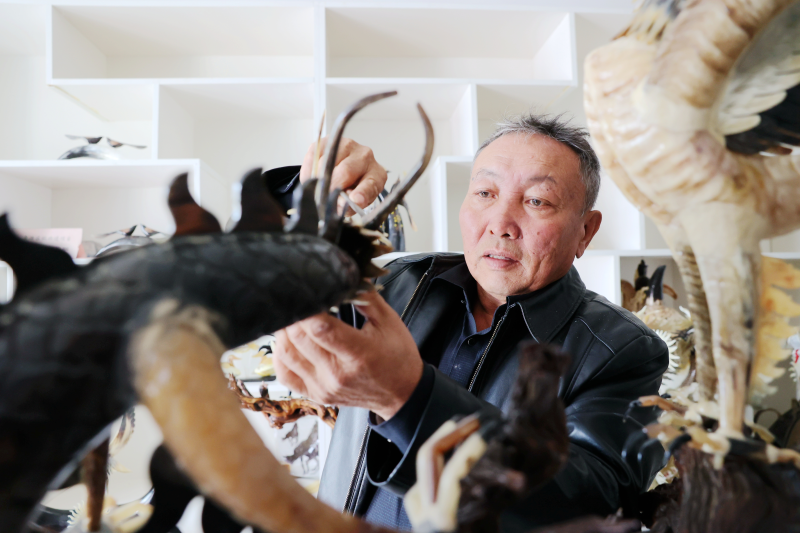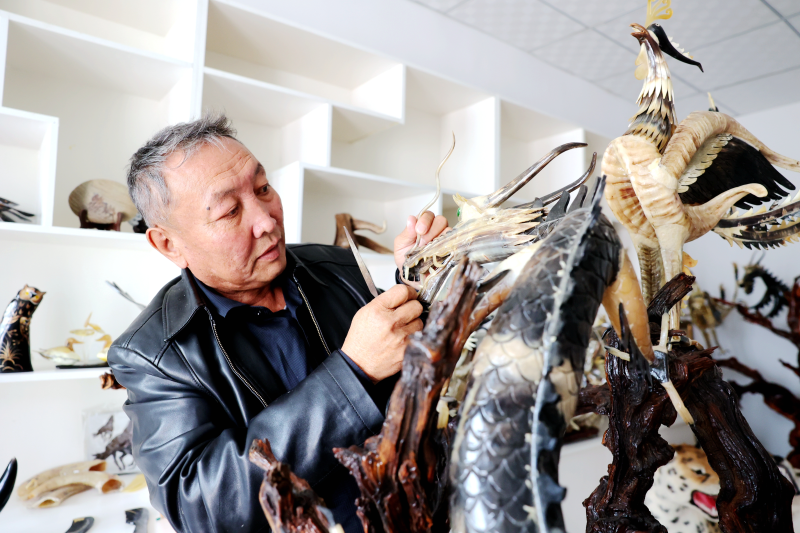"Bone carving is a traditional craft that has been passed down through generations, with the custom of elderly people making utilitarian objects from cattle and sheep horns and bones. My father and uncle, both accomplished carvers, sparked my passion for this art, leading me to embark on my own journey at the age of 27." On November 15, 2024, at Ashili Village in Ashili Township, Changji City, Changji Hui Autonomous Prefecture, northwest China's Xinjiang Uygur Autonomous Region, Duishan Nuerxiaerfu shared, "I take immense pride in evolving from a bone carving enthusiast to a recognized rural craftsman. I am committed to honing my skills and ensuring this craft is passed down through generations."

Photo shows Duishan Nuerxiaerfu makes a bone carving work in his studio. (Photo by Liang Hongtao)
In Duishan Nuerxiaerfu's studio, numerous artworks crafted from animal bones and horns are elegantly framed, varying in size, theme, and dynamic form. The studio is adorned with exquisite pieces feature Chinese dragons and phoenixes, as well as soaring birds, all meticulously crafted from materials such as cattle and sheep horns, each piece vividly lifelike.
"Each bone carving undergoes a meticulous process that includes material selection, shaping, bone scraping, pattern drawing, carving, polishing, and coloring, involving dozens of steps where precision is paramount. Larger pieces particularly require endurance." Under the guidance of his father and uncle, Duishan Nuerxiaerfu has become increasingly adept in the art of bone carving. "Smaller items, like wine flasks and cow horn combs, can be completed in two to three days, while larger works require significant time, often taking half a month or even longer," Duishan Nuerxiaerfu explained.

Photo shows Duishan Nuerxiaerfu makes a bone carving work in his studio. (Photo by Liang Hongtao)
As an autonomous region-level inheritor of bone carving, a national intangible cultural heritage, Duishan Nuerxiaerfu primarily utilizes commonly found materials such as cattle and sheep horns. Because the horns of cows and sheep are small in size, there is not much freedom to choose when carving, and carving can only be done based on the shape of the raw materials. Therefore, the design of horn carvings is completed entirely in the mind, without drawing any plans, and sometimes it is even done while thinking.
"Now I promote traditional bone carving crafts through new media platforms and participate in various intangible cultural heritage expos, where I have received multiple awards," Duishan Nuerxiaerfu said. "With the support of the township, my works have also been marketed as a tourism product with local features from Ashili Township, generating economic benefits for me."
As one of the oldest carving arts in China, bone carving is a vital component of traditional Chinese craftsmanship.
To keep this ancient skill alive, Changji City and Ashili Township have taken advantage of opportunities such as night schools for farmers and winter skill training programs to have Duishan Nuerxiaerfu teach villagers about traditional bone carving techniques. They also take villagers to visit Duishan Nuerxiaerfu's studio for hands-on observation.
"It is not enough for me to carry this alone; we need more people to appreciate and fall in love with bone carving so that this art form does not fade away," Duishan Nuerxiaerfu said. "At present, I have 30 apprentices hailing from various regions across the region, and four of them have established their own studios, which is very promising."
With tourism booming in Xinjiang, the cultural significance, practical uses, and economic prospects of bone carvings have gained attention. Duishan Nuerxiaerfu has harnessed his bone carving skills to create a diverse array of tourist souvenirs. "I've aimed to craft compact, locally-themed pieces that are easy to transport, as well as bone-carved musical instruments, expanding the reach and value of bone carving artistry," explains Duishan Nuerxiaerfu.
(The Media Convergence Center of Changji City, Reporters: Liang Hongtao and Zhang Yuanyuan, Correspondent: Saltanat)









